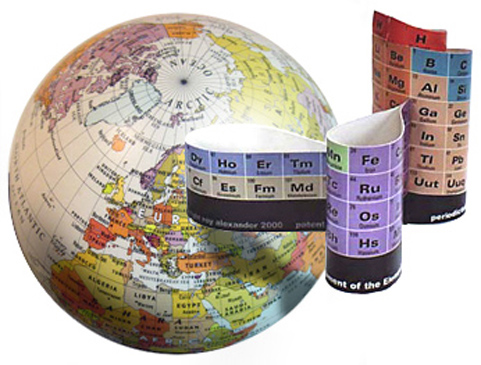![]()
![]()
Questions? Call Us 1–773–271–0318 9am to 2pm Central Time Mon.–Fri.

Roy Alexander and the Re–Discovery of the 3D Periodic Table
![]() I am primarily a museum science exhibit designer. In a design office where I worked in 1965 I saw a listing of a stack of drawings by another designer that identified one of the drawings as '3D Periodic Table'. I had recently been having discussions with friends concerning concepts of reality, and had concluded that all real things must have at least three dimensions, and was convinced that the periodic table, of all things, was real – what reflected reality more? ...or more of reality!
I am primarily a museum science exhibit designer. In a design office where I worked in 1965 I saw a listing of a stack of drawings by another designer that identified one of the drawings as '3D Periodic Table'. I had recently been having discussions with friends concerning concepts of reality, and had concluded that all real things must have at least three dimensions, and was convinced that the periodic table, of all things, was real – what reflected reality more? ...or more of reality!
![]() I eagerly searched up the drawing, but was disappointed to find it to be a standard flat table with raised letters. But I was already hooked on the 3D periodic table idea. I 'knew' the design concept was valid, and in an hour or so, proved it, letting the element blocks loop to make adjacent a perfect atomic number sequence. The table needed only one adjustment to work perfectly, the downslant of an area in the p–block so each period descends to
I eagerly searched up the drawing, but was disappointed to find it to be a standard flat table with raised letters. But I was already hooked on the 3D periodic table idea. I 'knew' the design concept was valid, and in an hour or so, proved it, letting the element blocks loop to make adjacent a perfect atomic number sequence. The table needed only one adjustment to work perfectly, the downslant of an area in the p–block so each period descends to
 meet the start of the one below (spiral? multi helix?), eliminating the 12+ breaks in the atomic number sequence without disturbing vertical relationships.
meet the start of the one below (spiral? multi helix?), eliminating the 12+ breaks in the atomic number sequence without disturbing vertical relationships.
![]() At the time I had no idea that others had developed a similar technique to build a 3D table – including Alexandre-Emile Beguyer de Chancourtois, who is credited with being the first to publish a periodic table showing the periodicity of element properties.
At the time I had no idea that others had developed a similar technique to build a 3D table – including Alexandre-Emile Beguyer de Chancourtois, who is credited with being the first to publish a periodic table showing the periodicity of element properties.
![]() The Alexander Arrangement form brings the Seaborg created f–block into the table rather than being awkwardly orphaned. This, and the more modern way of thinking about Hydrogen – as being in more families than one – affirms the advantages of 3D.
The Alexander Arrangement form brings the Seaborg created f–block into the table rather than being awkwardly orphaned. This, and the more modern way of thinking about Hydrogen – as being in more families than one – affirms the advantages of 3D.
![]() Subsequent study of the Periodic Law and the periodic table's value in education revealed that my basic rationale for developing the Alexander Arrangement of Elements was only one of the many good reasons for producing it for the public to share, so I applied for and was granted a U.S. patent on the downslant in order to produce the AAE teaching/learning aids.
Subsequent study of the Periodic Law and the periodic table's value in education revealed that my basic rationale for developing the Alexander Arrangement of Elements was only one of the many good reasons for producing it for the public to share, so I applied for and was granted a U.S. patent on the downslant in order to produce the AAE teaching/learning aids.

![]() Initially, my goal was introduction of the AAE into classrooms, laboratories, chemistry textbooks, and reference material, universally replacing the conventional flat form.
Initially, my goal was introduction of the AAE into classrooms, laboratories, chemistry textbooks, and reference material, universally replacing the conventional flat form.
![]() After a decade of investigation of chemistry & science curricula, however, I have learned that a 3D periodic table is best applied in the initial introduction of the periodic table to new students, much as the world globe initiates the study of world maps – 3D is the reality, flat printed adaptations are projections to flat paper for convenience and economy.
After a decade of investigation of chemistry & science curricula, however, I have learned that a 3D periodic table is best applied in the initial introduction of the periodic table to new students, much as the world globe initiates the study of world maps – 3D is the reality, flat printed adaptations are projections to flat paper for convenience and economy.
![]() The familiar icon of chemistry, in spite of its misleading shape, can not be readily replaced by a dimensional object, but the Alexander Arrangement, during introduction to chemistry, will help make sense of the need for breaks and gaps in the familiar form – flattened for convenience of printing and distribution – as printed world map projections are far handier than globes.
The familiar icon of chemistry, in spite of its misleading shape, can not be readily replaced by a dimensional object, but the Alexander Arrangement, during introduction to chemistry, will help make sense of the need for breaks and gaps in the familiar form – flattened for convenience of printing and distribution – as printed world map projections are far handier than globes.
Roy Alexander of AlexanderDESIGN, on discoveries of the true arrangement of the elements
AlexanderDESIGN 4851 N. Washtenaw Ave., Chicago, IL 60625 773.271.0318
last update 3/1/14